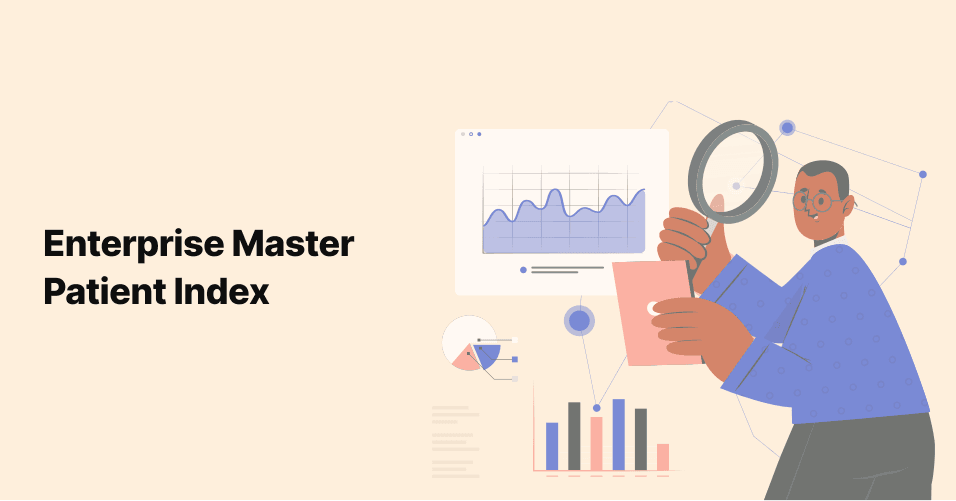
Exploring Muspell Archive’s Dual Data Security Layers
Legacy patient health data holds a wealth of information, including crucial historical insights, essential for …

Duplicate, inconsistent, and incomplete patient records put patient lives at risk and in addition, your hospital and health system’s bottom line. A survey by Black Book™ Research highlighted two startling statistics:
Respondents also reported that Provider Organizations with Enterprise Master Patient Index (EMPI) tools said a very high number of consistently correct patient identification at an overall average of 93% of registrations and 85% of externally shared records among non-networked providers. In this post, we will cover:
Before diving into the Enterprise Master Patient Index, let us first understand the Master Patient Index or MPI.
A Master Patient Index (MPI), interchangeably called a Patient Master Index, Patient Registry, or a Client Registry, is a list of all patients who have received care from the organization. The main aim of an MPI is to minimize duplication of patient information in the organization’s records by assigning them a unique identifier.
But in a mid-sized provider organization, it is common to have hundreds of clinical information systems with their Master Patient Indexes. While they all try to minimize duplication of information in their lists (databases), they often don’t share that information resulting in difficulties mapping the same patient’s data across information systems.
In Healthcare IT, the phrase “Enterprise” is often used to symbolize a cross-system over-arching phenomenon. Therefore, an Enterprise Master Patient Index (EMPI) means a cross-system, centrally governed solution that uniquely identifies a patient across all the information systems prevailing in a healthcare organization. A good EMPI system uses complex matching algorithms to find its way through multiple MPIs and match patients with very high success rates.
An EMPI solution leverages deterministic and probabilistic matching algorithms to compare a slew of patient data elements like demographics, insurance information, dependent information, etc. It can have a variety of data items collected from across information systems. In addition, EMPIs can be customized to report at pre-determined confidence levels. For example, if you configure the EMPI at a 90% confidence level, any match below 90% will be shown as a potential match and will require human approval.
Data Linking - When data from multiple clinical systems are merged, or the health system acquires a new organization, and their data needs to be merged, there is a need for Data Linkage to be established between the patients across systems/organizations. This task is usually done once at the time of merging data across clinical systems or at the time of onboarding the new organization in the health system. This involves extensive data crunching, human effort, and multiple iterations. The outcome of this is gold-standard data which basically serves the purpose of Master Data Management (MDM).
Finding duplicates - This is a routine activity to ensure that no duplicates have crept into the system. Many EMPI software can do this themselves internally, whereas others depend on external tooling to accomplish this.
Patient Search - When data is spread across clinical systems, EMPIs act as a conduit between them to search for patient information. The patient search can be triggered by the front desk person or at the time of data exchange via an interface.
Sharing data with external entities - When patient data needs to be de-identified and shared with external entities for research purposes, EMPI is particularly useful. This is a ubiquitous requirement in academic hospitals and pharma companies.
Accurate patient identification increases patient safety and compliance.
Patient data integrity is maintained, preventing incomplete and inaccurate records.
Prevents duplicate medical records reducing administrative and billing errors
For healthcare providers to offer the highest quality of care with minimal errors in the patient’s documentation, data must be correct, complete, and devoid of duplication. Solutions like Enterprise Master Patient Index (EMPI) can do just that for healthcare providers promoting data interoperability and data integrity for the highest quality decision making.
Join over 3,200 subscribers and keep up-to-date with the latest innovations & best practices in Healthcare IT.

Legacy patient health data holds a wealth of information, including crucial historical insights, essential for …

The relationship that your health system shares with the archive vendors is as crucial a process as health …

Access to health information by the patients or providers has always been a tedious and time-consuming …